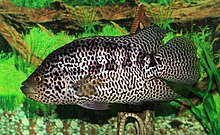Parachromis managuensis is a large species of cichlid native to freshwater habitats in Central America, where it is found from Honduras to Costa Rica.[2] The binomial name refers to Lake Managua in Nicaragua, from which the holotype was obtained.[3] It is a food fish and is also found in the aquarium trade where it is variously known as the jaguar cichlid, managuense cichlid, managua cichlid, guapote tigre, Aztec cichlid, spotted guapote and jaguar guapote.[2] In Costa Rica, it is known as the guapote tigre.[4]
| Parachromis managuensis | |
|---|---|

| |
| Scientific classification | |
| Domain: | Eukaryota |
| Kingdom: | Animalia |
| Phylum: | Chordata |
| Class: | Actinopterygii |
| Order: | Cichliformes |
| Family: | Cichlidae |
| Genus: | Parachromis |
| Species: | P. managuensis
|
| Binomial name | |
| Parachromis managuensis (Günther, 1867)
| |
| Synonyms[2] | |
| |
Description
editP. managuensis is a robust fish with a silvery or golden-green to purple colour, with a darker moss green shade at the dorsum. The sides show a purple iridescence and the belly is whitish or yellowish. A series of several large black dots then run horizontally along the lateral line area. The fins are often a dark to black coloration, especially when in spawning coloration. The most distinguished feature is a black stripe than run from the eye to the opercular margin.[2] Males grow to a total length of 65 centimetres (26 in) and females to 40 centimetres (16 in).[5] The female also lacks the elongated extensions to the dorsal fins.
Ecology
editP. managuensis inhabits lakes and prefers turbid waters with mud bottoms and is tolerant to eutrophic and hypoxic conditions.[5] It is a carnivorous, highly predatory species. Adults feed mainly on small fish, while juveniles rely on a variety of macroinvertebrates. It prefers turbid, eutrophic lakes, often found in warm water depleted of oxygen. Its native substrate is mud-bottoms, but it can also be found in ponds and springs with sandy bottoms covered in plant debris. The species inhabits lakes in a tropical climate and prefers water with a 7.0–8.7 pH, a water hardness of 10–15 dGH, and a temperature range of 25 to 36 °C (77 to 97 °F).[2]
Distribution
editThe natural distribution of P. managuensis goes from the Ulúa River in Honduras to Matina River basin in Costa Rica.[2] However, it has been introduced in other countries in Central America, as well as in the United States, as a food source, for aquarism and to control fish populations.[5]
Conservation status
editThis species has been assessed by the IUCN Red List as least-concern species.[1] It occurs in the Maquenque National Wildlife Refuge.[4]
See also
editReferences
edit- ^ a b Lyons, Tim J.; Matamoros, Wilfredo A. (2020). "Parachromis managuensis". IUCN Red List of Threatened Species. 2020: e.T18243419A161824499. doi:10.2305/IUCN.UK.2020-2.RLTS.T18243419A161824499.en. Archived from the original on 27 March 2024. Retrieved 9 April 2024.
- ^ a b c d e f Froese, Rainer; Pauly, Daniel (eds.). "Parachromis managuensis". FishBase. July 2022 version.
- ^ "California Academy of Sciences: Catalog of Fishes". Archived from the original on 22 February 2013. Retrieved 30 April 2020.
- ^ a b Varga, Mauricio Salas (July 2008). Humedales de Ramsar (FIR) – Versión 2006-2008 (PDF) (Report) (in Spanish). Centro Científico Tropical. p. 20. Archived (PDF) from the original on 27 March 2024. Retrieved 27 March 2024.
- ^ a b c Del Moral-Flores, Luis Fernando; Pintor, Rubén; García-Mercado, Eduardo; León, Cesar (18 November 2020). "A new record of the exotic Guapote jaguar, Parachromis managuensis (Günther, 1867) (Cichliformes, Cichlidae) in a tropical coastal lagoon of the Mexican Pacific slope". Neotropical Biology and Conservation. 15 (4): 479–485. doi:10.3897/neotropical.15.e57669. eISSN 2236-3777. Archived from the original on 27 March 2024.
